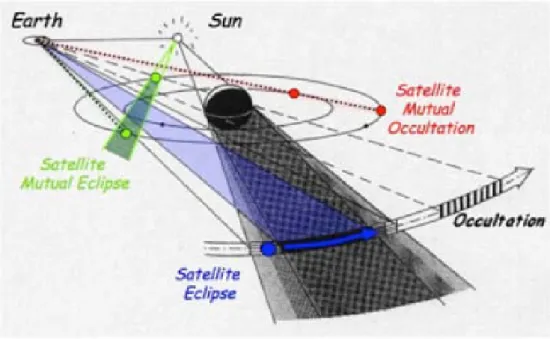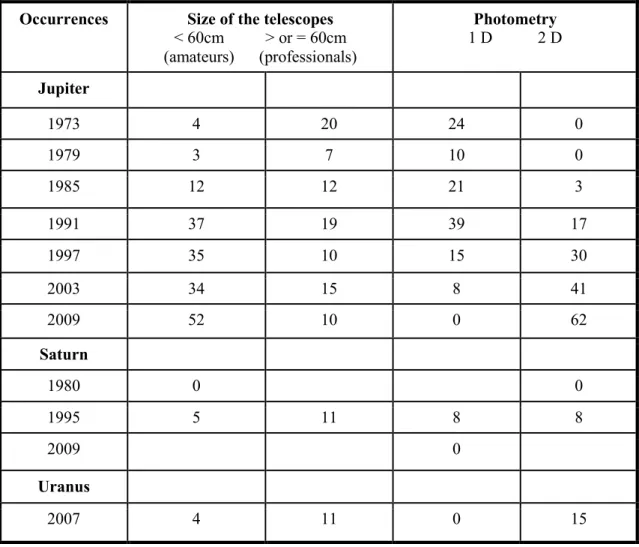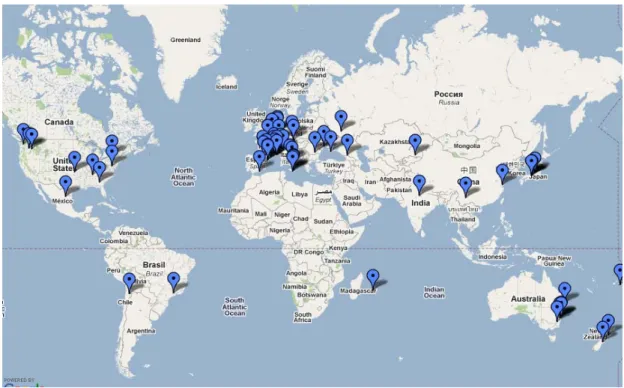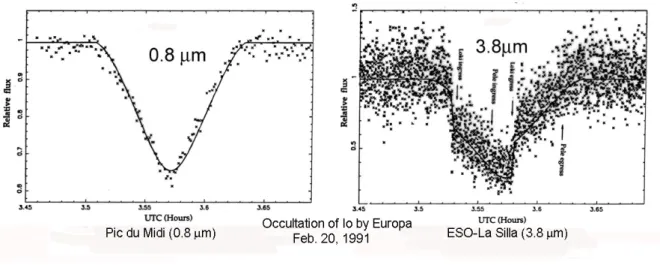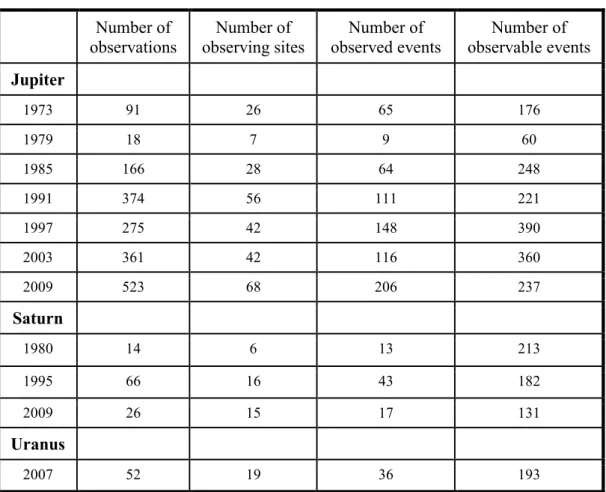HAL Id: hal-00602040
https://hal.sorbonne-universite.fr/hal-00602040
Submitted on 21 Jun 2011HAL is a multi-disciplinary open access archive for the deposit and dissemination of sci-entific research documents, whether they are pub-lished or not. The documents may come from teaching and research institutions in France or abroad, or from public or private research centers.
L’archive ouverte pluridisciplinaire HAL, est destinée au dépôt et à la diffusion de documents scientifiques de niveau recherche, publiés ou non, émanant des établissements d’enseignement et de recherche français ou étrangers, des laboratoires publics ou privés.
The Evolution of the Networks of Observers of
Phenomena
J. E. Arlot
To cite this version:
J. E. Arlot. The Evolution of the Networks of Observers of Phenomena. Workshop Gaia Fun-SSO : follow-up network for the Solar System Objects, Nov 2010, Paris, France. 149 p. �hal-00602040�
all of the target´s regions coming from the several frames. If the target motion is not linear, the regions orientation is also compensated for. Then in each region the barycenter of the illuminated portion is calculated. All regions are now co-added by the barycenter, at the nominal precision aimed at, and a bi-dimensional Gaussian is adjusted to the resulting distribution. The centroid is de-convoluted towards the orientation and scale of each frame, so that the original region is replaced by the compound one, but particular to the original frame instead of common to all of them. In this way one independent measurement is extracted for each frame. The independent measurements can finally be averaged, either using the ephemeris speed if it can be taken as correct for the total time range, or leaving a correction to the ephemeris speed as unknown.
4. Results and Conclusion
A series of observations of PLANCK was conducted at the 2m. Liverpool Robotic Telescope, at La Palma, from 10thto 18thAugust 2010. The integration time was 20sec and a sequence of 10 measurements was made daily. On these conditions, namely, brighter probe, longer integration time, and limited number of daily observations, the blind co-addition still improved the correction to the ephemeris. Relatively to a local frame of 2MASS stars, on the best observation night the error on R.A. went to 46mas and the DEC. error went to 58mas, respectively a reduction of 8mas and 2mas in comparison with the average of individual reductions. On the worst night, however, the same comparison shows an improvement on R.A. by 35mas but a worsening on DEC. by 24mas.
Fig. 5 – Compound images of PLANCK taken at the 2m LT at La Palma, for series of 10 exposures of 20sec. On the left the night of best seeing is depicted, and on the right that one of
worst seeing. Though nominally the error on the centroid is nearly the same (1mas), on the worst night there was no net improvement upon the results from the average of standard
astrometric reductions.
Both the Moving Gaussian and the Blind Co-addition offer a substantial improvement for the determination of the centroid of the GAIA satellite during its mission. Their utilization in the astrometric pipeline used by the GBOT/GAIA will hence depend of the actual satellite brightness, and variation, during the mission, as well of observational conditions, like seeing, number and length of exposures. The series of tests using PLANCK and selected asteroids will continue to improve the present procedures.
Arlot, J.-E.
IMCCE, UMR 8028 du CNRS, Paris Observatory, UPMC, USTL 77 av. Denfert-Rochereau, F-75014 Paris
Introduction
Astrometric observations are commonly measurements of angular positions of bodies on the celestial sphere in a given reference frame. However, the precision of such measurements is limited by the instruments and by the receptors used for these observations. Astronomers saw very early that celestial bodies were often involved in phenomena such as eclipses of the Sun or the Moon. Such phenomena correspond to specific positions of the involved bodies in space. At least, one may say that the topocentric positions of the Moon and the Sun are very close at the time of an eclipse. This is an astrometric observation. Since the possible phenomena are numerous in the solar system thanks to the velocity of the moving objects, astronomers made predictions of such events and made observations as precise as possible in order to deduce astrometric positions from these events. Of course, a model was necessary for that purpose but this was the main way to improve our knowledge of the solar system at the beginning of astronomical research.
1. What phenomena? 1.1 Jovian satellites eclipses
After the eclipses of the Sun and the Moon, the phenomena the most observed by the astronomers were the eclipses of the satellites of Jupiter by the planet Jupiter. As soon as Galileo observed these satellites, he understood the phenomenon of the eclipse occurring very often (Io makes a revolution around Jupiter in one day and an half and is eclipsed each time!). It was then easier to date each eclipse in order to get the period of the satellites than measuring the relative positions of the satellites.
From Galileo until the beginning of the XXth century, Jovian eclipses of the satellites were extensively observed and were the basis for the building of the dynamical models of the motion of the Galilean satellites. The theories by Laplace (end of the XVIIIth century) and Sampson (beginning of the XXthcentury) are among the most achieved analytical models and are based on eclipses. However, the precision of these observations is limited by the refraction of light in the upper atmosphere of Jupiter determining the shadow cone. The progress of the direct astrometry thanks to the apparition of the photographic technique led to the decline of the use of eclipses. During the XXth century, the photographic technique was the main source of observations of the Galilean satellites.
1.2 Mutual events of the natural planetary satellites
As seen on figure 1, the eclipses by Jupiter are not the only phenomena occurring in the Jovian system: the satellites may eclipse and occult themselves since they are in the same orbital plane. Then, when the Sun (and the Earth which is close to the Sun as seen from Jupiter) crosses the common orbital plane of the satellites, mutual eclipses and occultations occur. Note that this occurs at the equinox on Jupiter since the orbital plane of the satellites is the equatorial plane of Jupiter. The interest of these events is that the satellites have no atmosphere so that the precision of the observations is higher than the one of the eclipses by Jupiter and also higher than the one of the photographic data. However, these observations started only after 1973 because of the need of computers to make the prediction of the events. These events occur not only in the Jovian system but also in the systems of Saturn and Uranus since they have large satellites orbiting in their equatorial plane. Note that these events occur at the equinox on the planet i.e. every 6 years for Jupiter, 15 years for Saturn and 42 years for Uranus. These observations are then a complement of high accuracy to the direct ground based astrometric measurements as data from space probes available only on short intervals of time. It is easy to understand that these events occur at any time and that the observations are possible only from selected geographic area. More, the observers may not wait for favorable weather, so that an organized network of observers is necessary.
1.3 Occultations of stars
All the moving objects of the solar system may occult a star on their way on the celestial sphere. Such an occultation is similar to a solar eclipse, the Sun being replaced by a star and the Moon by any moving object. For small objects for which the resolution of the telescopes does not allow to measure the size, each occultation provides one measurement of the size of the object. Several occultations observed from close sites will provide a complete profile of the object. As for solar eclipses, the total occultation is observable only from a central path where the observers should be placed. A network of observers is necessary to get useful observations.
2. Mutual events: the history
Galileo observed the first eclipse by Jupiter in 1612 but it was only in 1693 that Arnoldt observed an occultation of Europa by Ganymede. Such observations occurred only by chance when observing the satellites but the calculation of prediction was not possible at that time. The calculations were difficult because of the sensitivity of these events to the accuracy of the position of the satellites near 100 km. Such accuracy needs the use of a complete dynamical model for the calculations. At the beginning of the XXth century, the Sampson’s theory was sufficient for such predictions but the algorithm needed too many calculations. From the 1970’s, computers were used for astronomical calculations and precise predictions of mutual
From Galileo until the beginning of the XXth century, Jovian eclipses of the satellites were extensively observed and were the basis for the building of the dynamical models of the motion of the Galilean satellites. The theories by Laplace (end of the XVIIIth century) and Sampson (beginning of the XXthcentury) are among the most achieved analytical models and are based on eclipses. However, the precision of these observations is limited by the refraction of light in the upper atmosphere of Jupiter determining the shadow cone. The progress of the direct astrometry thanks to the apparition of the photographic technique led to the decline of the use of eclipses. During the XXth century, the photographic technique was the main source of observations of the Galilean satellites.
1.2 Mutual events of the natural planetary satellites
As seen on figure 1, the eclipses by Jupiter are not the only phenomena occurring in the Jovian system: the satellites may eclipse and occult themselves since they are in the same orbital plane. Then, when the Sun (and the Earth which is close to the Sun as seen from Jupiter) crosses the common orbital plane of the satellites, mutual eclipses and occultations occur. Note that this occurs at the equinox on Jupiter since the orbital plane of the satellites is the equatorial plane of Jupiter. The interest of these events is that the satellites have no atmosphere so that the precision of the observations is higher than the one of the eclipses by Jupiter and also higher than the one of the photographic data. However, these observations started only after 1973 because of the need of computers to make the prediction of the events. These events occur not only in the Jovian system but also in the systems of Saturn and Uranus since they have large satellites orbiting in their equatorial plane. Note that these events occur at the equinox on the planet i.e. every 6 years for Jupiter, 15 years for Saturn and 42 years for Uranus. These observations are then a complement of high accuracy to the direct ground based astrometric measurements as data from space probes available only on short intervals of time. It is easy to understand that these events occur at any time and that the observations are possible only from selected geographic area. More, the observers may not wait for favorable weather, so that an organized network of observers is necessary.
1.3 Occultations of stars
All the moving objects of the solar system may occult a star on their way on the celestial sphere. Such an occultation is similar to a solar eclipse, the Sun being replaced by a star and the Moon by any moving object. For small objects for which the resolution of the telescopes does not allow to measure the size, each occultation provides one measurement of the size of the object. Several occultations observed from close sites will provide a complete profile of the object. As for solar eclipses, the total occultation is observable only from a central path where the observers should be placed. A network of observers is necessary to get useful observations.
2. Mutual events: the history
Galileo observed the first eclipse by Jupiter in 1612 but it was only in 1693 that Arnoldt observed an occultation of Europa by Ganymede. Such observations occurred only by chance when observing the satellites but the calculation of prediction was not possible at that time. The calculations were difficult because of the sensitivity of these events to the accuracy of the position of the satellites near 100 km. Such accuracy needs the use of a complete dynamical model for the calculations. At the beginning of the XXth century, the Sampson’s theory was sufficient for such predictions but the algorithm needed too many calculations. From the 1970’s, computers were used for astronomical calculations and precise predictions of mutual
events were published (Arlot, 1973, Brinkman, 1973). Since these events were rare and could provide relative positions and diameters of the satellites, observers were numerous to try to catch some events during the favorable occurrence of 1973. Even the Galilean satellites are bright, the recording of the events needed a fast photometric receptor associated to a telescope the aperture of which being larger than 50 cm: an occultation or an eclipse was only a few minutes long. Since made by photometrists, the observations were of good quality, well calibrated. The only problem was to be sure of the time scale: each event must be observed in the Universal Time scale in order to be linked to the other events and to the theoretical model. 3. The observers, the material and the network
1.1 The first observers
The first observers were professional astronomers using 50cm-telescope or larger. They were photometrists using a photoelectric photometer. Some amateurs tried to make visual observations using the methods developed for variable stars observation.
Table 1 – Evolution of the size of the telescopes and of the receptors Occurrences Size of the telescopes
< 60cm > or = 60cm (amateurs) (professionals) Photometry 1 D 2 D Jupiter 1973 4 20 24 0 1979 3 7 10 0 1985 12 12 21 3 1991 37 19 39 17 1997 35 10 15 30 2003 34 15 8 41 2009 52 10 0 62 Saturn 1980 0 0 1995 5 11 8 8 2009 0 Uranus 2007 4 11 0 15
Table 1 provides the evolution of the telescopes and receptors used for the observation of the mutual events. Seven Jovian occurrences allowed the observation of the mutual events of the Galilean satellites and about 1800 observations were made. At the beginning, large telescopes managed by professional astronomers equipped with single channel photoelectric photometers were the more numerous systems of observations. From 1985, 2D receptors such as CCD cameras appeared and were used allowing recording a reference object at the same time than
the occulted or eclipsed satellites: observations were possible even in difficult conditions such as twilight or fog. The problem was to record images with a high frequency (more than one image per second) that was difficult at the beginning of the use of the CCD’s. The progress of that type of 2D receptors led to the disappearance of the 1D receptor for the 2009 occurrence. Correlatively, the part of amateur’s observations grew rapidly due to increase of the sensitivity of the receptors allowing using small telescopes. Specific training of the observers was made in order to learn the basis of photometry and also to understand the need of the use of an accurate time scale linked to UTC.
1.2 The observers today
To day, small fast CCD cameras such as Watec are widely used associated to 20 or 30cm-aperture telescopes: such material is easy to get and the number of observing sites of the network increases. Nowadays, the network (cf. figure 2) allows observing as many events as possible and includes ninety percent amateur astronomers. Internet provides help and software for the reduction to the observers and images are broadcasted through the Web.
Fig. 2 – The present PHEMU network of observers
1.3 The Saturnian and Uranian events
The success of the observation of the mutual events of the Galilean satellites led to try the observation of the same events for the Saturnian and Uranian satellites. For those systems, some difficulties arose: the field was smaller because of the increased distance of the satellites from the Earth leading to a smaller apparent distance satellites-planet and the bright planet (plus ring for Saturn) made difficult the observations. More, for the Uranian satellites, their faint magnitude made the use of large telescope necessary. For example, only one event was observable through a small telescope in the visible wavelength thanks to its distance to the planet at the time of the event: all the other events occurred too close to the planet Uranus, too bright in the visible wavelength. Then, these events needed the use of infra red filters making the planet very dark. However, such K’ filter implied the use of large telescopes from the 3.5m-NTT (cf. an image in figure 3) to the 8m-VLT (Arlot et al., XXX).
the occulted or eclipsed satellites: observations were possible even in difficult conditions such as twilight or fog. The problem was to record images with a high frequency (more than one image per second) that was difficult at the beginning of the use of the CCD’s. The progress of that type of 2D receptors led to the disappearance of the 1D receptor for the 2009 occurrence. Correlatively, the part of amateur’s observations grew rapidly due to increase of the sensitivity of the receptors allowing using small telescopes. Specific training of the observers was made in order to learn the basis of photometry and also to understand the need of the use of an accurate time scale linked to UTC.
1.2 The observers today
To day, small fast CCD cameras such as Watec are widely used associated to 20 or 30cm-aperture telescopes: such material is easy to get and the number of observing sites of the network increases. Nowadays, the network (cf. figure 2) allows observing as many events as possible and includes ninety percent amateur astronomers. Internet provides help and software for the reduction to the observers and images are broadcasted through the Web.
Fig. 2 – The present PHEMU network of observers
1.3 The Saturnian and Uranian events
The success of the observation of the mutual events of the Galilean satellites led to try the observation of the same events for the Saturnian and Uranian satellites. For those systems, some difficulties arose: the field was smaller because of the increased distance of the satellites from the Earth leading to a smaller apparent distance satellites-planet and the bright planet (plus ring for Saturn) made difficult the observations. More, for the Uranian satellites, their faint magnitude made the use of large telescope necessary. For example, only one event was observable through a small telescope in the visible wavelength thanks to its distance to the planet at the time of the event: all the other events occurred too close to the planet Uranus, too bright in the visible wavelength. Then, these events needed the use of infra red filters making the planet very dark. However, such K’ filter implied the use of large telescopes from the 3.5m-NTT (cf. an image in figure 3) to the 8m-VLT (Arlot et al., XXX).
Fig. 3 – The Uranian satellites as seen with the NTT in the K’-band.
The planet Uranus is darker than the satellites (except the small Miranda)
4. The results of thirty years of campaigns
1.1 Using the data
The first use of the observations of mutual events has two purposes: the determination of relative positions between two satellites and the measure of the radii of the satellites (at that time, the space probes had not yet provide these data). These quantities were correlated but numerous observations permitted to de correlate them. After the accurate determination of the radii by the space probes, it appeared that the mutual events were sensitive to the law of reflection of the light at the surface of the satellites which was the explanation of non symmetrical light curves. More, it appeared that the observation in infra red should show the hot spots at the surface of Io (Descamps et al., XXX) through their occultation (figure 4).
Fig. 4 – Occultation of Io by Europa:
the occultation of the hot spots are visible on the light curve at right
Nowadays, the hot spots may be observed through specific 2D infra red receptors. The analysis of the light curves allows now to determine highly accurate relative positions of the satellites used for the fit of the new theoretical dynamical models. After 30 years of observations of mutual events and one century of photographic observations, small effects in the orbital motion of the satellites such as tidal effects may be detected (Lainey et al., XXXX, Lainey et al. 2009).
1.2 Reusing the old data
Table 2 provides the number of observations gathered since the beginning of the observational campaign. The first light curves were analogical and their analysis very simple. It is possible to digitize them and to apply a better algorithm to determine the relative positions of the satellites. The search for older data allowed us to find in publications the measurement of the time of conjunction between satellites with a poor accuracy, not useful nowadays.
Table 2 – Observations made since the beginning of the campaigns Number of
observations observing sitesNumber of observed eventsNumber of observable eventsNumber of
Jupiter 1973 91 26 65 176 1979 18 7 9 60 1985 166 28 64 248 1991 374 56 111 221 1997 275 42 148 390 2003 361 42 116 360 2009 523 68 206 237 Saturn 1980 14 6 13 213 1995 66 16 43 182 2009 26 15 17 131 Uranus 2007 52 19 36 193 Conclusion
The example of the network of observers of the mutual events of the natural planetary satellites shows an evolution which depends on the progress of the receptors. More and more amateur astronomers may participate to the observations of phenomena that allows the increase of the number of observations. The network of observers of occultation of stars, using the same material, are more dependant of each event, observable only on a small area: in this case, the observers must move towards the best observing places. For any other observational campaign, specific constraints may appear but the technical progress of the material to be used and of the communication through Internet makes the things easier for observers.
References
Arlot, J.E.: 1973, Les occultations et les eclipses mutuelles des satellites galiléens de Jupiter, L’Astronomie, 87, 287.
Arlot, J.E., Dumas, C., Sicardy, B.: 2008, Observation of an eclipse of U-3 Titania by U-2 Umbriel on December 8, 2007 with ESO-VLT, A&A 492, 599
Brinkmann, R.T., Millis, R.L.: 1973, Mutual Phenomena of Jupiter's Satellites in 1973-74, Sky & Telescope 45, 93.
Descamps, P.; Arlot, J. E.; Thuillot, W.; Colas, F.; Vu, D. T.; Bouchet, P.; Hainaut, O.: 1992, Observations of the volcanoes of Io, Loki and Pele, made in 1991 at the ESO during an occultation by Europa, Icarus 100, 235.
Table 2 – Observations made since the beginning of the campaigns Number of
observations observing sitesNumber of observed eventsNumber of observable eventsNumber of
Jupiter 1973 91 26 65 176 1979 18 7 9 60 1985 166 28 64 248 1991 374 56 111 221 1997 275 42 148 390 2003 361 42 116 360 2009 523 68 206 237 Saturn 1980 14 6 13 213 1995 66 16 43 182 2009 26 15 17 131 Uranus 2007 52 19 36 193 Conclusion
The example of the network of observers of the mutual events of the natural planetary satellites shows an evolution which depends on the progress of the receptors. More and more amateur astronomers may participate to the observations of phenomena that allows the increase of the number of observations. The network of observers of occultation of stars, using the same material, are more dependant of each event, observable only on a small area: in this case, the observers must move towards the best observing places. For any other observational campaign, specific constraints may appear but the technical progress of the material to be used and of the communication through Internet makes the things easier for observers.
References
Arlot, J.E.: 1973, Les occultations et les eclipses mutuelles des satellites galiléens de Jupiter, L’Astronomie, 87, 287.
Arlot, J.E., Dumas, C., Sicardy, B.: 2008, Observation of an eclipse of U-3 Titania by U-2 Umbriel on December 8, 2007 with ESO-VLT, A&A 492, 599
Brinkmann, R.T., Millis, R.L.: 1973, Mutual Phenomena of Jupiter's Satellites in 1973-74, Sky & Telescope 45, 93.
Descamps, P.; Arlot, J. E.; Thuillot, W.; Colas, F.; Vu, D. T.; Bouchet, P.; Hainaut, O.: 1992, Observations of the volcanoes of Io, Loki and Pele, made in 1991 at the ESO during an occultation by Europa, Icarus 100, 235.
Lainey, V.; Arlot, J. E.; Vienne, A.: 2004, New accurate ephemerides for the Galilean satellites of Jupiter. II. Fitting the observations, A&A 427, 371.
Lainey, V., Arlot, J.E., Karatekin, O., van Hoolst, T.: 2009, The thermal equilibrium of Io, Nature, 459, 957-959
